- August 24, 2016 10H:24 GMT/UTC/ZULU TIME
- Europe
A magnitude 6.2 earthquake has struck central Italy, leaving at least 21 people dead and many others trapped under rubble, reports say.
Many of the dead were in the village of Pescara del Tronto which was levelled to the ground and there were fears the number could rise.
Much of the town of Amatrice was reduced to rubble and a family of four were feared dead nearby in Accumoli.
The quake hit at 03:36 (01:36 GMT), 100km (65 miles) north-east of Rome.
Although it struck at a shallow depth of 10km, its intensity was compared to the Aquila earthquake in April 2009 in which 309 people died. The epicentre was around Accumoli where several people died.
Some buildings in the capital shook for 20 seconds as the quake struck an area between the regions of Umbria, Lazio and Marche. It was felt from Bologna in the north to Naples in the south.
- Read here for latest updates
- History of deadly earthquakes
- Why Italy is hit by earthquakes
- Can quakes be predicted?
The highest casualties were reported in the small village of Pescara del Tronto, where 10 people were reported dead, among them children. Twenty people have been taken to hospital.
Two boys aged four and seven were pulled alive from the rubble of the house they had been staying in with their grandmother, Ansa news agency reported. Rescuers said they had been sheltering under a bed.
More damage was reported a short distance up the road in Arquata del Tronto.
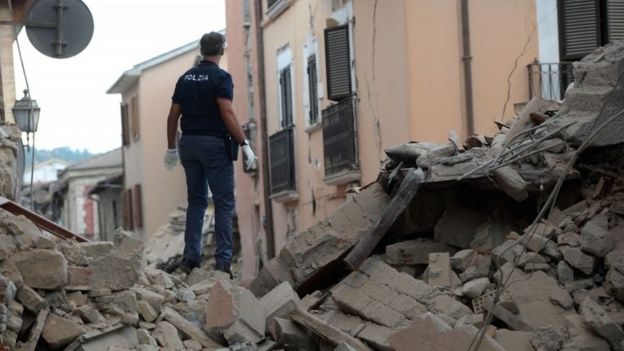 AFP
AFP
Some of the worst damage was in the town of Amatrice, where at least five died and rescue efforts were under way to find survivors.
"The roads in and out of town are cut off. Half the town is gone. There are people under the rubble. There's been a landslide and a bridge might collapse," said mayor Sergio Pirozzi.
"There are tens of victims, so many under the rubble. We're preparing a place for the bodies," he said.
The main street through the town has been devastated and emergency workers are trying to reach six people in a collapsed building.
 ITALIAN FIRE BRIGADE
ITALIAN FIRE BRIGADE
In Accumoli, a short distance to the north, Mayor Stefano Petrucci said one person had been pulled out of the rubble during the night.
"Then there is a family of four under a collapsed house and sadly there are two small children among them."
A local photographer spoke of 15 rescuers digging with their bare hands trying reach the family.
"They hear the screams of the mum and one of the children," he said.
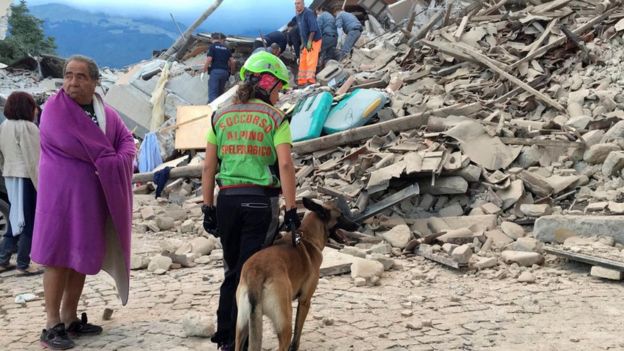 REUTERS
REUTERS
Seismologist Andrea Tertulliani said there were sure to be further, numerous shocks that would probably diminish in intensity.
"But it can't be ruled out that there could be another shock on the same scale as the main one," he said.
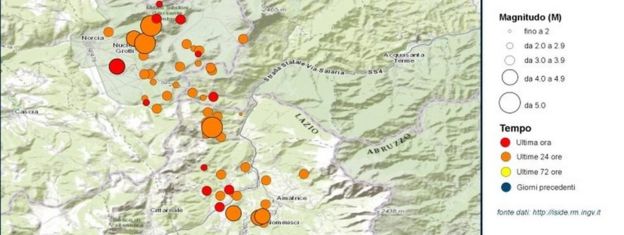 INGVTERREMOTI
INGVTERREMOTI
Italy's Civil Protection agency described the earthquake as "severe".
"It was so strong. It seemed the bed was walking across the room by itself with us on it," Lina Mercantini of Ceselli, Umbria, told Reuters.
Rescue teams are being sent to the worst-hit areas, the prime minister's office said.
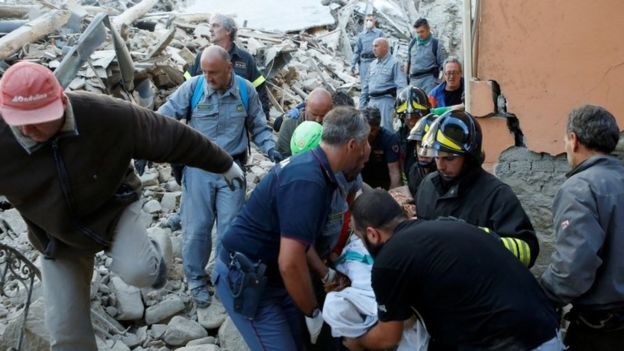 REUTERS
REUTERS REUTERS
REUTERSWhy is Italy at risk of earthquakes? By Jonathan Amos
Quakes are an ever-present danger for those who live along the Apennine mountain range in Italy.
Through the centuries thousands have died as a result of tremors equal to, or not much bigger than, the event that struck in the early hours of Wednesday. The modern response, thankfully, has been more robust building and better preparation.
Mediterranean seismicity is driven by the great collision between the African and Eurasian tectonic plates; but when it comes down to the specifics of this latest quake, the details are far more complicated.
The Tyrrhenian Basin, or Sea, which lies to the west of Italy, between the mainland and Sardinia/Corsica, is slowly opening up.
Scientists say this is contributing to extension, or "pull-apart", along the Apennines. This stress is compounded by movement in the east, in the Adriatic.
The result is a major fault system that runs the length of the mountain range with a series of smaller faults that fan off to the sides. The foundations of cities like Perugia and L'Aquila stand on top of it all.
The quake was initially reported as being magnitude 6.4. It was followed by several powerful aftershocks, La Repubblica newspaper reported.
The deputy editor of the British newspaper, The Times, who was in the area at the time, told the BBC that the quake lasted about 20 seconds followed by an aftershock about 20 minutes later which was easily as strong.
"It was pitch dark, very cold. Nobody in our group had a clue what to do in an earthquake," Emma Tucker said.
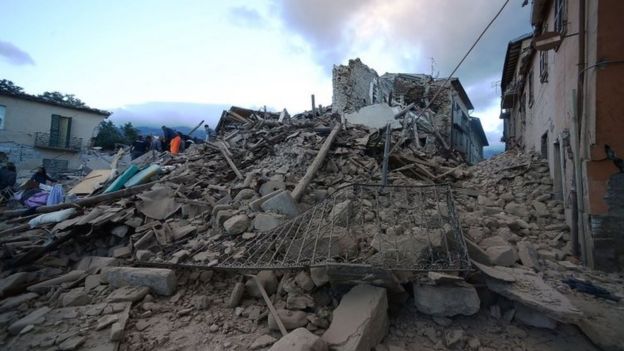 AFP
AFP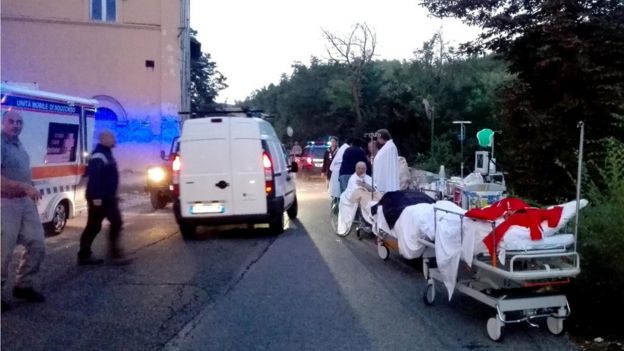 EPA
EPA REUTERS
REUTERS
The USGS predicted the damage could be significant, based on data from previous quakes.
It said the quake struck near the Umbrian city of Norcia, whose picturesque historic centre is a popular tourist site.
However Norcia Mayor Nicola Alemanno said no deaths have been reported there.
"The anti-seismic structures of the town have held," he said. "There is damage to the historic heritage and buildings, but we do not have any serious injuries."
In 2009, a 6.3-magnitude earthquake in the Aquila region, which was also felt in the Italian capital, left more than 300 dead.
Are you in the area? Have you been affected? You can share your experiences by emailing haveyoursay@bbc.co.uk.
Please include a contact number if you are willing to speak to a BBC journalist. You can also contact us in the following ways:
- Whatsapp: +44 7525 900971
- Send pictures/video to yourpics@bbc.co.uk
- Upload your pictures / video here
- Tweet: @BBC_HaveYourSay
- Send an SMS or MMS to +44 7624 800 100
Or use the form below

No comments:
Post a Comment